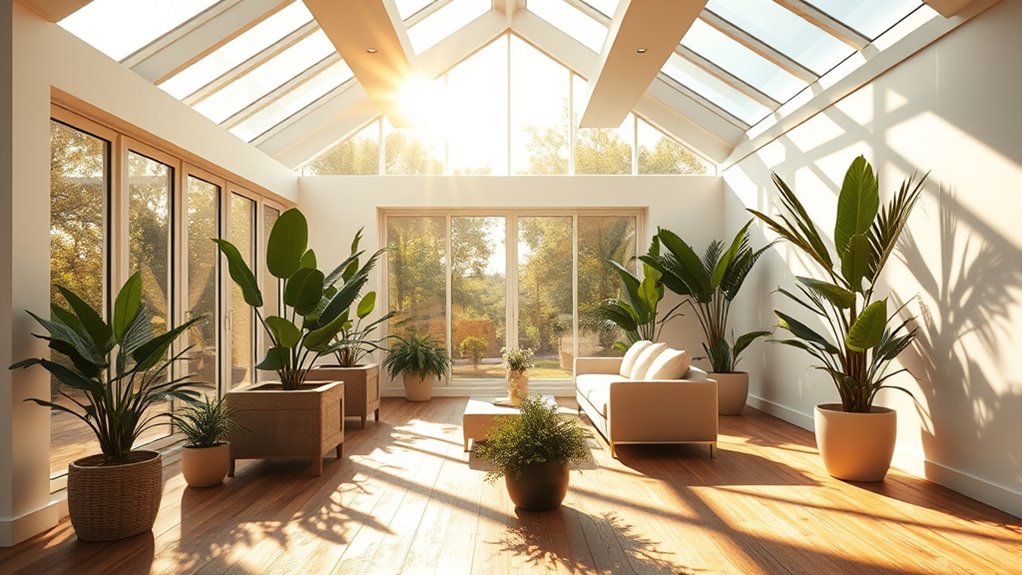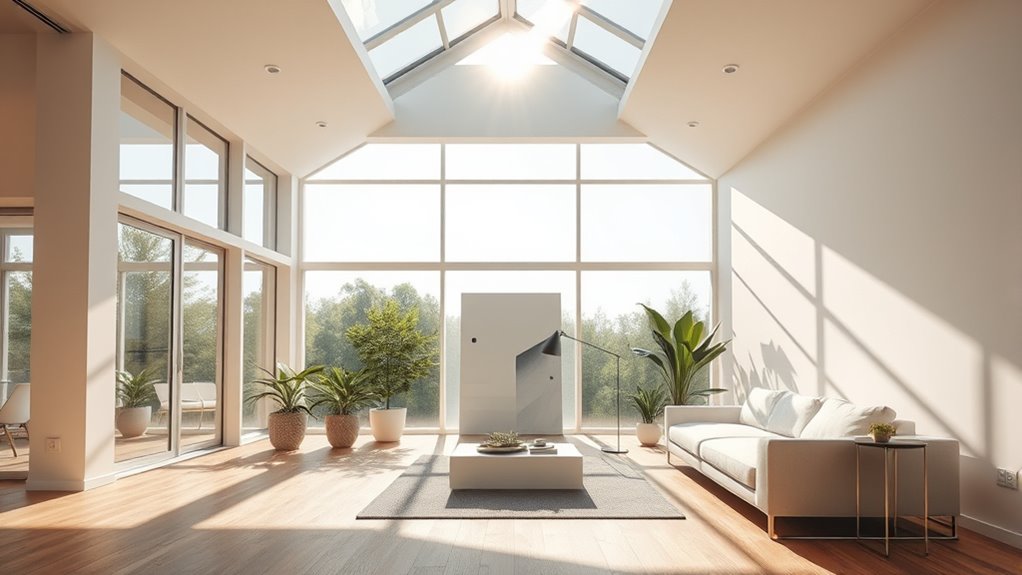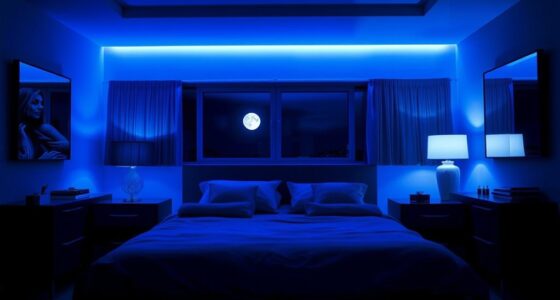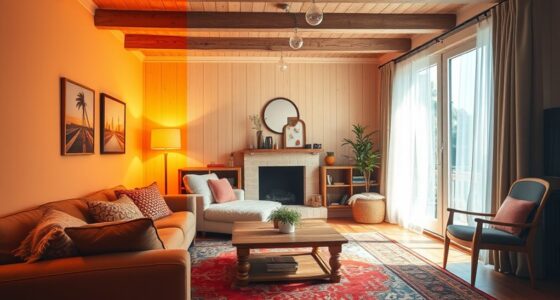To maximize natural light in your home, strategically place windows to catch sunlight at different times of day—south-facing for winter warmth, east-facing for morning light, and west-facing for late afternoon glow. Incorporate skylights like fixed or ventilating styles to flood spaces with daylight and improve airflow. Proper placement reduces glare and overheating while enhancing aesthetics and energy efficiency. Keep exploring to discover how clever window and skylight designs can create a brighter, more inviting living environment.
Key Takeaways
- Strategically position south-facing windows to optimize sunlight during winter and enhance energy efficiency.
- Use a mix of window orientations to balance natural light, reduce glare, and control heat gain throughout the day.
- Incorporate skylights—fixed, ventilating, or tubular—based on the room’s lighting and ventilation needs.
- Design window placements to maximize daylight penetration while maintaining privacy and minimizing overheating.
- Balance aesthetics, functionality, and energy efficiency by selecting appropriate window types and placement strategies.

Have you ever wondered how to transform a space with natural light? It’s one of the most effective ways to make your home feel brighter, more welcoming, and even more spacious. The key lies in thoughtful design, especially in how you approach window placement and skylight types. When you plan your windows carefully, you control the flow of sunlight, enhancing both functionality and aesthetics. Proper window placement isn’t just about aesthetics; it’s about optimizing light throughout the day and creating a balanced, inviting atmosphere. For instance, placing windows on the south side of your home allows maximum sunlight during winter months, warming your space naturally. East-facing windows bring gentle morning light, awakening your rooms without overwhelming them, while west-facing windows capture the warm glow of late afternoon and evening. North-facing windows, on the other hand, provide consistent, diffuse light without harsh shadows, ideal for spaces where you want even illumination without glare. By considering these aspects, you ensure your space receives the right amount of light at the right time, reducing dependency on artificial lighting and creating a pleasant environment. Additionally, understanding natural light distribution helps you plan your window placement more effectively for optimal results.
When it comes to skylight types, your options can dramatically influence how much natural light enters your space and how it’s distributed. Fixed skylights, for example, are non-operable but excel at flooding rooms with daylight, making them perfect for areas where you don’t need ventilation. Ventilating skylights, which open and close, add the benefit of fresh air, helping regulate temperature and improve air quality. There are also tubular skylights, which are ideal for smaller spaces or areas where traditional skylights might not fit, funneling sunlight through a reflective tube to brighten up even the darkest corners. The choice of skylight type depends on your specific needs—whether you prioritize maximum light, ventilation, or a combination of both. In addition, consider the placement of skylights to avoid glare or overheating, especially in rooms with lots of glass or direct sunlight exposure. Proper positioning and selecting the right skylight type can bring natural light deep into your home, reducing energy costs and creating a seamless connection with the outdoors.
Designing with windows and skylights means balancing aesthetics, functionality, and energy efficiency. By carefully considering window placement and choosing appropriate skylight types, you maximize natural light while controlling heat gain, glare, and privacy. When executed thoughtfully, your space can be transformed into a bright, airy haven that feels alive and connected to nature. This approach not only enhances your daily living experience but also adds value and style to your home, proving that good lighting design is truly an investment in comfort and sustainability.
Frequently Asked Questions
How Do I Prevent Glare From Windows and Skylights?
To prevent glare from windows and skylights, you should use window treatments like blinds, shades, or curtains for glare control. Adjust them throughout the day to block direct sunlight while still letting in natural light. Consider installing window films or tinted glass to reduce glare further. Additionally, positioning furniture away from direct sunlight and using diffusing window coverings helps create a comfortable, glare-free space.
What Are the Best Window Types for Energy Efficiency?
Imagine your windows as the armor protecting your home’s energy. Opt for vinyl or fiberglass frames, like sturdy shields, offering excellent insulation. Choose double or triple-glazed glass with superior insulation properties, acting like a thermal blanket. These window types minimize heat transfer, helping you save on energy costs and stay comfortable year-round. By selecting energy-efficient frames and glass, you fortify your home against the elements with style and durability.
How Can I Control Temperature With Natural Lighting?
You can control temperature with natural lighting by incorporating thermal insulation in your windows and walls, which helps maintain consistent indoor temperatures. Additionally, use solar shading devices like blinds, shutters, or overhangs to block excess heat during hot days and let sunlight in during colder periods. These strategies work together to optimize natural light while keeping your space comfortable year-round.
What Privacy Solutions Are Available With Large Windows?
You can enhance privacy with large windows using options like window tinting and frosted glass. Window tinting reduces visibility from outside while still letting light in, and frosted glass provides a natural barrier that obscures views. These solutions balance privacy and natural light, so you enjoy your space without feeling exposed. Choose the one that best fits your style and privacy needs, creating a comfortable, well-lit environment.
How Do I Maintain Indoor Air Quality With More Natural Light?
Think of your home as a living organism that breathes. To maintain indoor air quality with more natural light, you should enhance air filtration by installing high-quality filters and ventilation systems. Regularly open windows to flush out indoor pollutants and improve airflow. Using air purifiers can also help. This way, you let in sunlight while ensuring fresh, clean air flows freely, keeping your space healthy and vibrant.
Conclusion
Maximizing natural light with well-placed windows and skylights transforms your space into a brighter, more inviting home. While some worry about increased energy costs or glare, strategic placement and quality glazing can minimize these issues. Remember, the benefits of improved mood, lower energy bills, and a connection to the outdoors outweigh the minor concerns. By thoughtfully designing with natural light, you create a healthier, more vibrant environment that truly feels like home.








